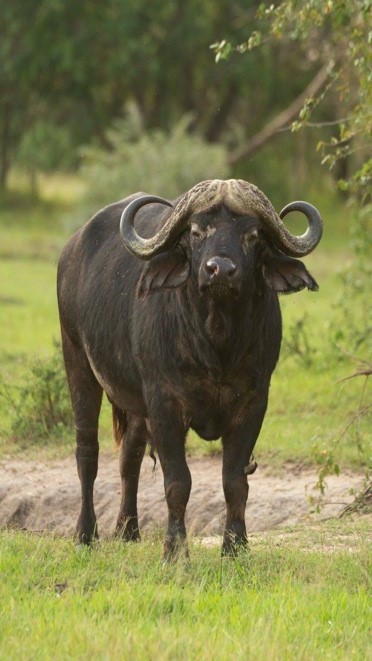Description

Disclaimer: Copyright infringement not intended.
Context
- Chhattisgarh forest department has carried out a successful translocation of four sub-adult wild buffaloes from Assam to Chattisgarh’s Barnawapara wildlife sanctuary in Mahasamund district after Chhattisgarh High Court cleared the hurdles as part of the state's ongoing efforts to protect and conserve the state animal.
About Barnawapara Wildlife Sanctuary
- Barnawapara Wildlife sanctuary, is named after Bar and Nawapara forest villages, which are in the heart of the sanctuary.
Geography
- It is a land mass of undulating terrain dotted with numerous low and high hillocks well forested area of North-eastern corner of Raipur district.
- The Tributaries of Mahanadi are the source of water.
- River Balamdehi forms the western boundary and Jonk River forms the north-eastern boundary of the Sanctuary.
Vegetation
- The well stocked forests of the sanctuary classified as teas, sal and mixed forests.
- This sanctuary is famous for the frequent sighting of the Indian bison (Gaur) Cheetal, Sambhar, Neelgai, Wild boar are commonly seen.
- Bar-Nawapara boosts of over 150 species Birds.

About Indian Wild Buffalo
- The Indian Wild Buffalo is the state animal of Chhattisgarh and is a large species of bovine native to the Indian Sub-continent and South East Asia.
- This magnificent animal is an ancestor of domestic Buffalo and is genetically invaluable.
- The total population of this animal all over the world is only about 4,000 of which half of the population lives in India itself.
- In India also, majority of the population lives in North – East India.
- In India, tourists from all over the world flock to Kaziranga National Park of Assam to have amazing sightings of this animal.
- This animal is also important to the ecosystem because it helps in the rejuvenation of grasslands.
Indian Wild Buffalo Facts
|
Kingdom
|
Animalia
|
|
Class
|
Mammalia
|
|
Order
|
Artiodactyla
|
|
Family
|
Bovidae
|
|
Sub Family
|
Bovinae
|
|
Genus
|
Bubalus
|
|
Species
|
B. arnee
|
|
Status
|
Endangered
|
|
Lifestyle
|
Generally solitary
|
|
Lifespan
|
25 years in wild | 29 years in captivity
|
|
Gestation Period
|
300 to 340 days
|
|
Sexual maturity
|
Puberty starts in 18 months
|
|
Number of offspring
|
Usually 1 calf per birth.
|
Physical Characteristics
- The Indian Wild Buffalo are very massive animals and are larger than domestic buffalo.
- They generally weigh around 700 to 1,200 kg.
- Both the females and the males bear horns.
- They are the second heaviest living bovid species on earth.
- Their huge structure has kept them safe amongst the bug cat species like tiger also.
Habitat
- The wild buffalo is mainly found in the alluvial grasslands, marshes, swamps and river valleys.
- They are generally found in areas that have plenty of water holes and resources..
Diet
- They are generally grazers and mainly feed upon grasslands. Their diet also consists of herbs, fruits, barks, sedges. Wild buffalo also feeds on crops like rice, sugarcane and jute.

Behavior
- They generally live in groups and adult males form large herds containing 10 to 20 members.
- Each group has a home range of about 3.9 square kilometers, which contains water holes and grazing areas.
- Older males generally prefer to live in solitude.
Threats
- The IUCN has listed Asiatic wild Buffalo as endangered. There are many reasons that are responsible for the declining population of this animal.
-
- Interbreeding with domestic buffalos makes this species of buffalo comparatively weaker.
- The hunting of wild buffalos in various countries for horns has led to the decline in population of this animal.
- Habitat loss due to expansion in agriculture ad hydel power projects is also another major cause.
- Wild Buffalos are also susceptible to Epidemic diseases spread by domestic buffalos.
- As water source is the main lifeline for wild buffalo, water scarcity in their living space has also led to their decreasing population.
- The invasion of exotic species of perennial plant Mikania sp. Has also led to the destruction of their grazing grass fields.
Conservation
- The wild Buffalo has been largely protected in India.
- Cloning of female wild buffalo was also done in collaboration with National Dairy Research Institute (NDRI), Haryana.
|
PRACTICE QUESTION
Q) Which of the following statements with reference to Indian Wild Buffalo is/are incorrect?
a. They are the heaviest living bovid species on earth.
b. The Indian Wild Buffalo is the state animal of Maharashtra.
- a only
- b only
- both a and b
- neither a nor b
Correct Answer: 3
|

http://timesofindia.indiatimes.com/articleshow/99545533.cms?utm_source=contentofinterest&utm_medium=text&utm_campaign=cppst












